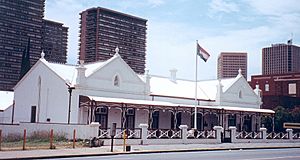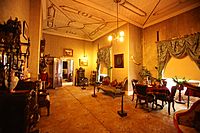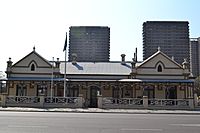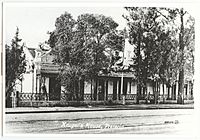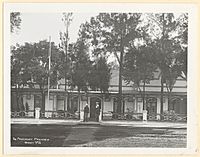Kruger House, Pretoria facts for kids
The Kruger House is a special historical home in Pretoria, South Africa. It used to be the house of Paul Kruger, who was a very important leader. He was the President of the South African Republic, which was a country that existed a long time ago.
This house was built in 1884. An architect named Tom Claridge and a builder named Charles Clark worked on it. Here's a cool fact: they used milk instead of water to mix the cement! This was because the cement back then wasn't very good, and milk helped make it stronger.
The Kruger House was also one of the first homes in Pretoria to have electric lights. Inside, you can see furniture and items from the time Paul Kruger lived there. There are also many gifts he received and other interesting things.
On the front porch, there are two stone lions. These lions were a birthday gift to President Kruger on October 10, 1896. They were given to him by a rich mining businessman named Barney Barnato.
Today, the Kruger House is a museum. It helps visitors imagine what life was like when President Kruger lived there.
Contents
The Story of Kruger House
How the House Was Built
Paul Kruger became a member of the Volksraad in 1863. The Volksraad was like the parliament or government meeting place. He bought several pieces of land on Church Street in Pretoria. He had other houses nearby before moving into this famous one.
In July 1884, the Kruger family moved into the house we know today. A well-known businessman, Alois Hugo Nellmapius, helped build it. Just a month later, on August 14, President Kruger hosted a big dinner party. About 60 guests came, including government members, lawyers, and pastors. They celebrated his "new official residence."
What the House Looks Like
The Kruger House has a mix of different building styles. You can see fancy designs on the gables and front door. These designs show touches of a style called Late Renaissance. The front and back porches, however, have an Asian look.
The house is a long, simple, and strong building. At the front, there are two large living rooms. Behind them are four bedrooms. The long, wide front porch was a famous spot. President Kruger often sat there and sometimes met with visitors.
Kruger Family Life in the House
President Kruger and his wife lived in the Kruger House for about 15 years and 10 months. They lived there from July 1884 until May 1900. Most of their children were already grown up and married by then.
On May 29, 1900, President Kruger left his home for the last time. This was just before the British army took over Pretoria. His wife stayed in the house until she passed away in 1901. Many family members, friends, and supporters came to say goodbye to him. A young boy named James F. Smith even brought 29,000 messages of sympathy from American boys.
After President Kruger Left
Just before President Kruger passed away in 1904, his son-in-law, Frederik Christoffel Eloff, bought the house. He put it in his son's name, Dirk Postma Eloff. While Dirk was away, the house was rented out as a bed-and-breakfast. It was even called "The Presidency," but Dirk didn't know about it.
President Kruger was buried in Pretoria on December 16, 1904. His funeral service was held right on the grounds of the house. It was between the Kruger House and the Pretoria Reformed Church (GKSA) across the street.
The House Becomes a Museum
From April 1920, the Kruger House was used as a maternity ward. This was a place where midwives trained and helped mothers give birth. Many Afrikaners can proudly say they were born in the Kruger House between 1920 and 1932!
Over time, people started to think the Kruger House should become a museum. This idea grew stronger when some of Kruger's personal items were brought back to Pretoria from a museum in the Netherlands. Some of these items were first shown in another museum on Boom Street.
The Kruger House officially opened as a museum on October 10, 1934. Mr. Albert Kuit opened it. People who knew President Kruger, like Mrs. LJ Jacobz and Col. Hermanus Christiaan Bredell, gave valuable photographs and other personal items to the museum.
On April 6, 1936, the house was declared a National Heritage Site. This means it's a very important historical place that needs to be protected. Since then, some extra buildings have been added to hold all the Kruger items. There's also an apartment and an office.
In 1952, the South African Railways gave the museum President Kruger's own train coach. The Kruger House later put this train coach on display in the garden under a special roof.
Today, the Kruger House Museum is looked after by the National Cultural History and Open Air Museum. On October 10, 1984, the house turned 100 years old. This was also the 50th anniversary of it being a museum!


